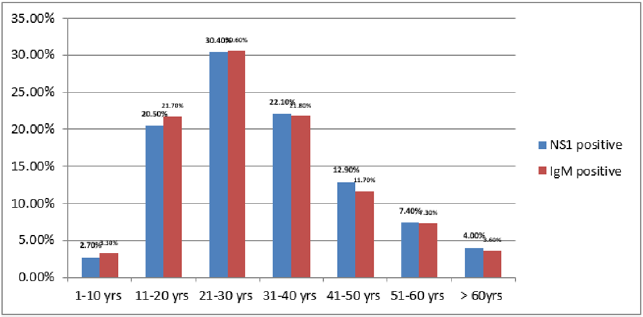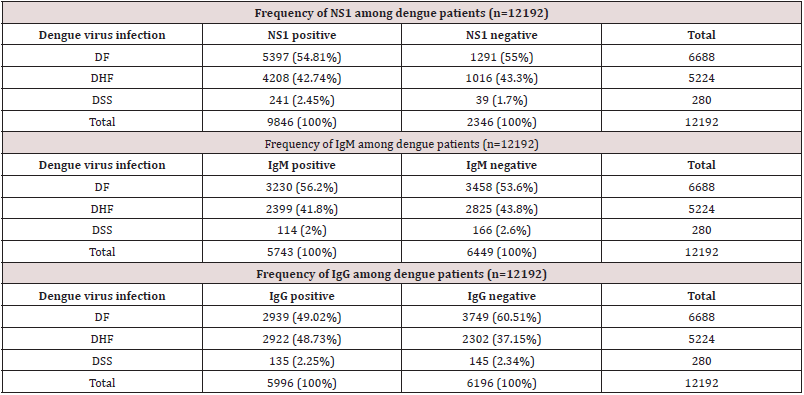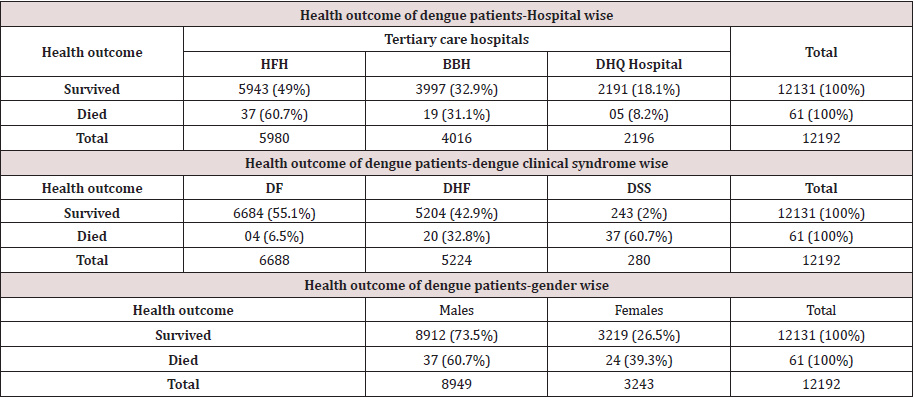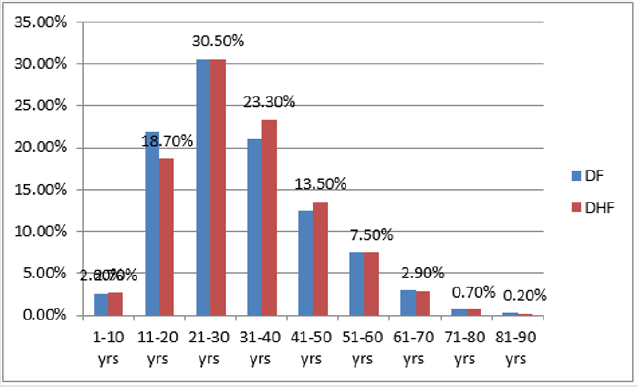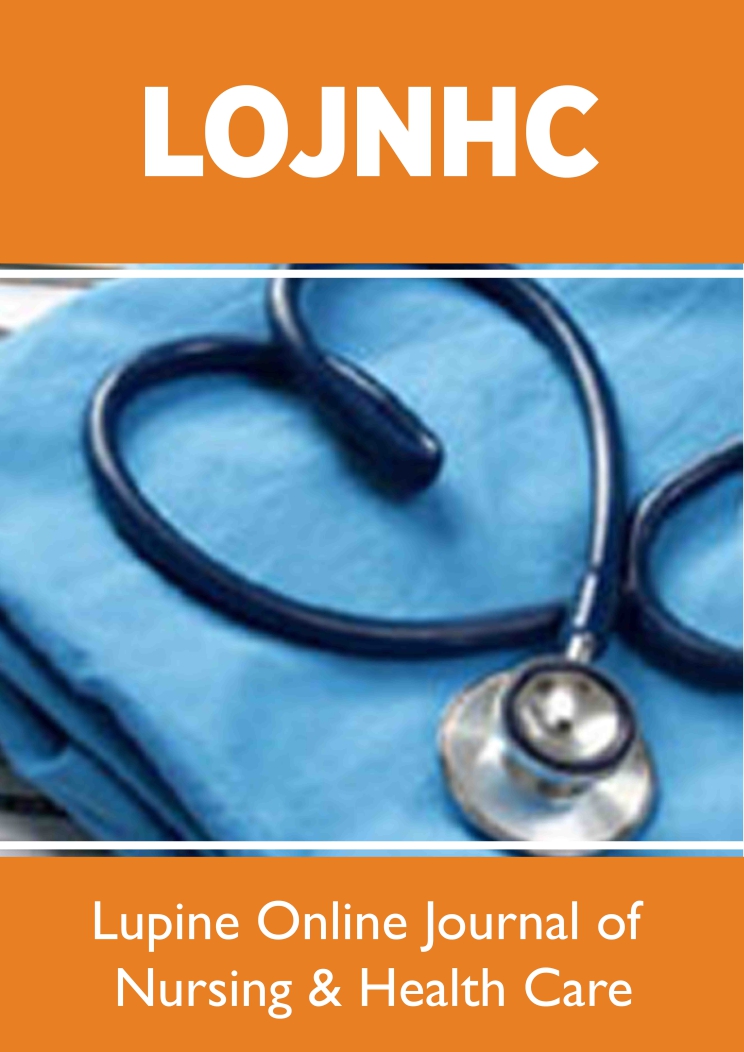
Lupine Publishers Group
Lupine Publishers
Menu
ISSN: 2637-6695
Research Article(ISSN: 2637-6695) 
Dengue Epidemic 2019–An Experience in Tertiary care Hospitals of Rawalpindi Medical University Pakistan Volume 2 - Issue 5
Shazia Zeb, Rizwana Shahid*, Muhammad Umar, Sumaira Yasmeen, Momina Zeb and Irum Kalsoom
- Rawalpindi Medical University, Pakistan
Received: February 27, 2020; Published: March 02, 2020
Corresponding author: Rizwana Shahid, Member of Faculty Research Forum, Rawalpindi Medical University, Pakistan
DOI: 10.32474/LOJNHC.2020.02.000148
Abstract
Objective: To determine the frequency of various dengue virus infections in tertiary care hospitals of Rawalpindi Medical University during dengue epidemic 2019.
Methods: A retrospective hospital data based study was carried out in three tertiary care hospitals (Holy Family Hospital, Benazir Bhutto Hospital and District Head Quarters Hospital) affiliated with Rawalpindi Medical University during dengue epidemic from September-November 2019. The data was gathered pertinent to demographics of dengue patients, frequency of dengue virus infections and length of hospital stay through convenience sampling. The data was analyzed by means of SPSS version 25.0.
Results: Of the total 12192 dengue patients 73.4% were males and majority of the dengue patients (49%) visited Holy Family Hospital. Mean age of the patients was 36±14.6 years and 62.8% patients were residents of Rawalpindi city. About 54.9% patients had dengue fever, while 42.8% and 2.3% patients had Dengue Hemorrhagic Fever (DHF) and Dengue Shock Syndrome (DSS) respectively. Majority of dengue patients (73.6%) registered in District Head Quarters hospital had Dengue Fever (DF), while mainstream of dengue hemorrhagic fever 47.7% was found in Holy Family Hospital. Only 2.3% patients had Dengue Shock Syndrome About 80.7% patients with dengue fever had NS1 positive 3% of which did not admit in hospital for treatment. IgM and IgG were positive among 47% and 49.2% dengue patients respectively. However, 28.5% dengue patients had both IgM and IgG positive in their blood serum. Of the total 61 (0.5%) deaths about 61% were males and 60.6% of deaths were among diagnosed cases of Dengue Shock Syndrome.
Conclusion: Dengue virus infections are more prevalent among males residing in Rawalpindi and Islamabad. It is deadly but curable. Timely and appropriate management of cases can result in significant reduction of death toll.
Keywords: Dengue Epidemic; Dengue Fever; Dengue Hemorrhagic Fever; Dengue Shock Syndrome; Tertiary Care Hospitals
Introduction
Dengue is a disastrous health problem found to be prevalent worldwide. It is acknowledged globally as one of the emerging infectious diseases [1]. About 128 countries are found to be suffering from this disease. Pakistan is facing a drastic dengue outbreak menace since 2005. Propagation and survival of 4 serotypes of Aedes mosquito in Pakistan is mainly attributed to climatic conditions, urbanization, communication gap and poor surveillance, thus paving the way towards emergence of peak incidence of this disease [2]. Approximately 50% of global population is residing in dengue prone regions and 100 million dengue cases are reported annually [3]. High mortality and morbidity are mainly attributed to dengue hemorrhagic fever and dengue shock syndrome that are the most severe form of this ailment [4]. Dengue disease manifests with varied clinical syndromes. Dengue fever among majority of patients is completely cured without complications [5]. Grave health outcomes are anticipated among cases of dengue hemorrhagic fever and dengue shock syndrome [6]. Even no internationally authorized vaccine is available for its prevention [7]. According to WHO statistics computed during dengue epidemic 2019, about 47,120 confirmed dengue fever cases were reported from all the provinces of Pakistan. Majority of them were from Rawalpindi and Islamabad and about 75 deaths were reported [8]. Even 47 new dengue cases were detected in twin cities of Rawalpindi and Islamabad from 25th November to 3rd December 2019 that constituted approximately 40% of the cases reported during dengue epidemic 2019. The current study is intended to determine the frequency of dengue virus infections reported in three tertiary care hospitals affiliated with Rawalpindi Medical University. Being public sector healthcare facilities, these hospitals cater and accommodate substantial population of Rawalpindi district. Therefore, research on dengue cases investigated and managed in these healthcare settings will be beneficial to the strategic planners in true sense to mitigate the disease burden in future.
Subjects and Methods
A retrospective hospital data based research was carried out in three tertiary care hospitals affiliated with Rawalpindi Medical University (RMU) through convenience sampling. These hospitals were Holy Family Hospital, Benazir Bhutto Hospital and DHQ Hospital. The study was conducted among total 12192 dengue patients who visited and received consultation in tertiary healthcare settings during 3 months from September-November 2019. Data was collected and studied pertinent to demographics, dengue virus infections, dengue infection markers, duration of hospital stay among dengue patients who visited each of the 3 tertiary hospitals of RMU during dengue epidemic 2019. Data was analyzed by using SPSS version 25.0.
Results
Of the total 12192 dengue patients admitted in tertiary care hospitals of Rawalpindi Medical University, majority (73.4%) were males as shown below in Table 1. Mean age of dengue patients in all three tertiary care hospitals was 36±14.6 years. About 62.8% dengue patients admitted in tertiary care hospitals of RMU belonged to Rawalpindi city followed by 34% from Islamabad. Varied cases of dengue virus infection with respect to each health care facility as well as gender wise is depicted below in Table 2. Mean hospital stay among dengue patients was found to be 1.28± 0.77 days. Of the total 12192 dengue patients who visited tertiary care hospitals of Rawalpindi Medical University, 377 patients got consultation and were investigated. However, these 377 patients did not get admission majority of which (65.2%) patients visited Holy Family Hospital for their health problem. Dengue virus infection among these non-admitted patients visiting tertiary care hospitals of Rawalpindi Medical University was determined as reflected in Table 3. About 3477 dengue patients had both IgM and IgG positive in their sera confirming the chronic or previous occurrence of dengue infection. About 5397 patients (80.7%) presenting with dengue fever had NS1 positive in their sera indicating the presence of dengue virus infection in their blood stream. Frequency of dengue virus serotypes among dengue patients visiting tertiary care hospitals of Rawalpindi Medical University is shown in Table 4. Out of 9846 patients having NS1 positive report, about 7960 (81%) patients stayed in healthcare settings and received managed care for 1-4 days. 21-30 years age group constituted the mainstream of the patients having NS1 and IgM positive among our study subjects as reflected in Figure 1.
Table 2: Hospital and gender-based distribution of dengue virus infection in tertiary care hospitals of RMU (n=12,192).

About 44.5% patients out of 9846 had acute infection due to positive IgM report. However, 299 (3%) patients despite of NS1 positive in their sera did not stay in hospital for treatment. Health outcome of our dengue patient’s hospital-wise, gender-wise and with respect to dengue clinical syndrome is given in Table 5. Of the total 61 deaths reported among dengue patients, 57.4% patients were residents of Rawalpindi, about 38% belonged to Islamabad and 3.3% were from Attock [9]. Only 01 death from dengue was reported in a resident of Gujar Khan. About 87% of the deaths were reported among those who stayed in hospital with dengue virus infection for 1-4 days as depicted below in Table 6. Majority of dengue fever and dengue hemorrhagic fever cases (30.5%) in our study were 21-30 years of age as depicted in Figure 1. About 19.7 % deaths were reported from each of the two groups of patients i.e., 11-20 years age group and 41-50 years age group as depicted below in Table 7. Health outcome of dengue patients age-wise is shown below in Table 7.
Majority of dengue patients who were registered in tertiary care hospitals of RMU had dengue fever (54.9%) followed by 42.8% cases of dengue hemorrhagic fever. Mainstream of DF and DHF was reported in age group of 21-30 years (Figure 2). Approximately 99.5% dengue patients presenting in our tertiary care hospitals were survived. Likewise, another national study carried out in various tertiary care hospitals of Pakistan depicted increased propensity of DF and DHF cases among 21-30 years age group [13]. This age group was also observed to be among the affected population in other South Asian regions of the world [18,19]. Although 73% of dengue fever cases were confirmed during dengue epidemic 2015 in Northern India but again the same age group constituted the chief component of sick population [20]. Special attention should be paid to this age group that mainly constitutes the economically independent population of a nation. The current study exposed the high frequency of NS1 and IgM positivity among 21-30 years age group of dengue patients that was confirmed in pathology laboratories of our tertiary care hospitals of Rawalpindi (Figure 1). The same results were also reported in a research carried out in 2014 by reviewing the laboratory reports of the dengue patients from various cities of Pakistan [13]. About 73% males in our study were confirmed to have dengue virus in their sera and acute viral infection. Greater viral infectivity among males is an aspect that should be given due consideration by our strategic planners to overcome the problem and prevent occurrence of dengue epidemic in future.
Conclusion and Recommendations
Dengue infection is more common among males of Rawalpindi city. Early diagnosis and symptomatic treatment of dengue cases at Primary health care level can not only drastically reduce the burden on tertiary health care facilities but also mitigate the severity of disease. Hematologic profile and co-morbidity among dengue patients should be scrutinized to rule out the factors attributing to severity of disease.
References
- Jahan F (2011) Dengue fever (DF) in Pakistan. Asia Pac Fam Med 10(1): 1.
- Ahmed S, Aziz MS, Aftab A, Ullah Z, Ahmad MI, et al. (2017) Epidemiology of dengue in Pakistan, present prevalence and guidelines for future control. International Journal of Mosquito Research 4(6): 25-32.
- Bhatt S, Gething PW, Brady OJ, Messina JP, Farlow AW, et al. (2013) The global distribution and burden of dengue. Nature 496(7446): 504-507.
- Khawsak P, Phantana S, Chansiri K (2003) Determination of dengue virus serotypes in Thailand using PCR based method. Southeast Asian J Trop Med Public Health 34(4): 781-785.
- Huy NT, Van GT, Thuy DHD, Kikuchi M, Hien TT, et al. (2013) Factors associated with dengue shock syndrome: A systematic review and meta-analysis. Plos Negl Trop Dis Sep 7(9): e2412.
- Ranjit S, Kissoon N (2011) Dengue hemorrhagic fever and shock syndromes. Pediatr Crit Care Med 12(1): 90-100.
- Yousaf MZ, Siddique A, Ashfaq UA, Ali M (2018) Scenario of dengue infection & its control in Pakistan: An up-date and way forward. Asian Pacific Journal of Tropical Medicine 11(1): 15-23.
- WHO? Dengue fever Pakistan.
- WHO-EMRO (2019) Outbreak update-Dengue in Pakistan, 1 December.
- Khalil MAM, Tan J, Khalil MA, Awan S, Rangasami M (2014) Predictors of Hospital stay and mortality in dengue virus infection experience from Agha Khan University Hospital Pakistan. BMC Res Notes 7: 473.
- Ahsan T (2008) Dengue fever: A regular epidemic? J Pak Med Assoc 58(1): 1-2.
- Mallhi TH, Khan AH, Sarriff A, Adnan AS, Khan YH (2017) Determinants of mortality and prolonged hospital stay among dengue patients attending tertiary care hospital: A cross sectional retrospective analysis. BMJ Open 7(7): e016805.
- Munir MA, Alam SE, Khan Z, Saeed Q, Arif A, et al. (2014) Dengue fever in patients admitted in tertiary care hospitals in Pakistan. JPMA 64(5): 553-559.
- Mallhi TH, Khan AH, Adnan AS, Sarriff A, Khan YH, et al. (2015) Clinico laboratory spectrum of dengue viral infection and risk factors associated with dengue hemorrhagic fever: A retrospective study. BMC Infectious Diseases 154: 399.
- Barrera R, Delgado N, Jimenez M, Valero S (2002) Eco-epidemiological factors associated with hyperendemic dengue hemorrhagic fever in Maracay city, Venezuela. Dengue Bull 26: 84-95.
- Gibbon RV, Vaughn DW (2002) Dengue: An escalating problem. BMJ 324(7353): 1563-1566.
- Guha Sapir D, Schimmer B (2005) Dengue fever: New paradigms for a changing epidemiology. Emerg Themes Epidemiol 2: 1.
- Ummar R, Faheem M, Riaz MN, Kanwal N, Jeved F, et al. (2011) Dengue fever in Indian sub-continent: An overview. J Infect Dev Ctries 5(4): 239-247.
- Chakarvarti A, Kumaria R (2005) Eco-epidemiological analysis of dengue infection during an outbreak of dengue fever, Indian. J Virol 2: 32.
- Laul A, Laul P, Merugumala V, Pathak R, Miglani U, et al. (2016) Clinical profiles of dengue infection during an outbreak in Northern India. J Trop Med 1-7.
Editorial Manager:
Email:

Top Editors
-

Mark E Smith
Bio chemistry
University of Texas Medical Branch, USA -

Lawrence A Presley
Department of Criminal Justice
Liberty University, USA -

Thomas W Miller
Department of Psychiatry
University of Kentucky, USA -

Gjumrakch Aliev
Department of Medicine
Gally International Biomedical Research & Consulting LLC, USA -

Christopher Bryant
Department of Urbanisation and Agricultural
Montreal university, USA -

Robert William Frare
Oral & Maxillofacial Pathology
New York University, USA -

Rudolph Modesto Navari
Gastroenterology and Hepatology
University of Alabama, UK -

Andrew Hague
Department of Medicine
Universities of Bradford, UK -

George Gregory Buttigieg
Maltese College of Obstetrics and Gynaecology, Europe -

Chen-Hsiung Yeh
Oncology
Circulogene Theranostics, England -
.png)
Emilio Bucio-Carrillo
Radiation Chemistry
National University of Mexico, USA -
.jpg)
Casey J Grenier
Analytical Chemistry
Wentworth Institute of Technology, USA -
Hany Atalah
Minimally Invasive Surgery
Mercer University school of Medicine, USA -

Abu-Hussein Muhamad
Pediatric Dentistry
University of Athens , Greece

The annual scholar awards from Lupine Publishers honor a selected number Read More...




